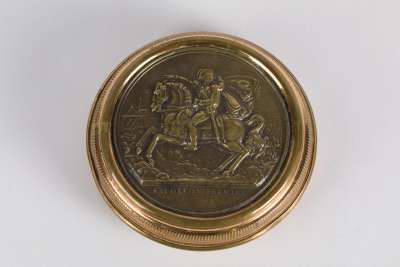This French Confectionery Box originates from the early 19th century, approximately between 1830 and 1840. Its distinctive feature is the reverse-painted lid, which vividly illustrates a scene believed to be from the French conquest of Algeria. The box is square, with dimensions that suggest it was designed to hold small confections or similar items. The craftsmanship hints at a French origin, with intricate detailing on the lid and a robust structure that speaks to its historical context. The paintwork on the lid is executed in a style consistent with the period, using techniques typical of French artisans of the time.
Condition Report
This antique French Confectionery Box is in good condition, showing minimal signs of age and wear. The reverse-painted lid remains intact, with the scene still clearly visible and vibrant, although some slight fading or minor scratches may be present as expected in pieces from this era. The structural integrity of the box is sound, with no visible warping or notable damage to the corners or edges. The surface of the box may exhibit minor scuffs or markings typical of its age, yet these do not detract from its overall visual appeal or function.
Dimensions
Weight: 100gm, Length: 15cm, Width: 15cm, Height: 2.5cm.
An Elegant Container for Delicacies
The original intended use of this box was likely to store and present small confections or sweets. During the early 19th century in France, confectionery boxes were often used to both preserve and display delicate treats. The visual allure of the box, paired with its practical design, made it a fitting choice for presenting sweets during social gatherings or as a gift. Such boxes were often placed prominently on tables, serving both a functional and decorative purpose.
French Romanticism in Decorative Arts
The style of the French Confectionery Box reflects the Romanticism that was prevalent during the early 19th century. Romanticism in France was marked by an emphasis on emotion and nature, often depicted through dramatic and vivid imagery in art. The painted scene on the lid is typical of this period, capturing a moment of historical significance with a focus on dramatic narrative. This style was popular among collectors and artisans alike, as it brought a sense of drama and storytelling into everyday objects.
Reverse Painting: A Delicate Art Form
Reverse painting on glass, as seen on the lid of this box, is an intricate art form that involves painting an image on the back of a glass surface. This technique requires precision and skill, as the artist must work in reverse, starting with the foreground details and finishing with the background. The process was popular in 19th-century France, often used to create detailed and colourful scenes on decorative items. The craftsmanship involved in this technique ensures the painted scene is protected by the glass, preserving its vibrancy over time.
Anonymous French Artisans
While the exact maker of this box remains unknown, it is representative of the work of skilled artisans in early 19th-century France. During this period, many artisans remained anonymous, contributing to a collective tradition of craftsmanship without attaching their names to their creations. These artisans were adept at combining practical design with artistic flair, producing items that were both functional and aesthetically pleasing. Such pieces were often commissioned by wealthy patrons or produced for the burgeoning middle class.
Collected for Historical and Artistic Value
Collectors of French antiques are often drawn to items such as this confectionery box for both their historical significance and artistic merit. The box represents a period of French history and craftsmanship, offering insights into the cultural and social practices of the time. Collectors appreciate the detailed work and historical context, making such items highly sought after in the antique market. The combination of functionality and artistry in this box makes it a valuable addition to collections focused on 19th-century French decorative arts.














